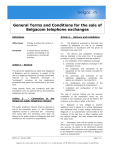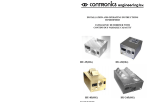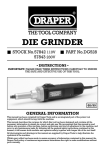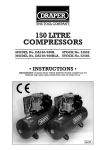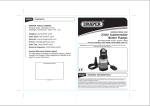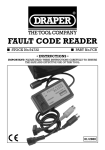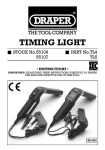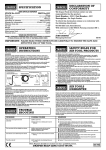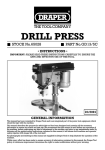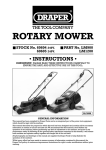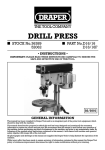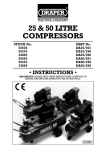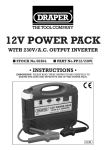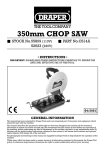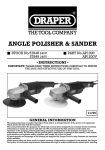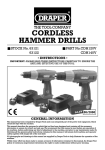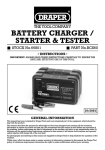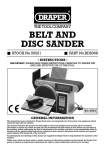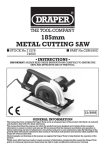Download Draper Drill Press Owner`s manual
Transcript
5 SPEED BENCH DRILL PRESS ■ MODEL No.D13/5A ■ STOCK No. 33662 • INSTRUCTIONS • IMPORTANT: PLEASE READ THESE INSTRUCTIONS CAREFULLY TO ENSURE THE SAFE AND EFFECTIVE USE OF THIS TOOL. 09/2001 GENERAL INFORMATION This manual has been compiled by Draper Tools and is an integrated part of the power tool equipment, which should be kept with the machine. This manual describes the purpose for which this tool has been designed and contains all the necessary information to ensure its correct and safe use. We recommend that this manual is read before any operation of the machine, before performing any kind of adjustment to the machine, and prior to any maintenance tasks. By following all the general safety instructions contained in this manual, it will ensure both machine and operator safety, together with longer life of the tool itself. All photographs and drawings in this manual are supplied by Draper Tools to help illustrate the operation of the machine. Whilst every effort has been made to ensure accuracy of information contained in this manual, the Draper Tool policy of continuous improvement determines the right to make modifications without prior warning. BENCH DRILL PRESS ■ PART No.D13/5A. ■ STOCK No.33662. CONTENTS: Page Nos. Specification/Guarantee ....................................................................................................................... 3 Unpacking/Checking Contents............................................................................................................. 4 Power Supply ........................................................................................................................................ 5 General Safety Instructions for Power Tools ......................................................................................... 6 Additional Safety Rules for Drill Presses ............................................................................................... 7 Know Your Bench Drill........................................................................................................................... 8 Assembly ........................................................................................................................................ 9-12 Speed/Belt Changing.......................................................................................................................... 13 Table Adjustment ................................................................................................................................ 14 Spindle Return Spring Adjustment ...................................................................................................... 15 Depth Setting ................................................................................................................................. 15-16 Operation............................................................................................................................................ 16 Troubleshooting ................................................................................................................................. 17 Optional Accessories .......................................................................................................................... 18 DECLARATION OF CONFORMITY We Draper Tools Ltd. Hursley Road, Chandlers Ford, Eastleigh, Hampshire. SO53 1YF. England. Declare under our sole responsibility that the product: Stock No.:- 33662 Part No:- D13/5A Description:- Bench Drill To which this declaration relates is in conformity with the following directive(s) 73/23 EEC & 89/366/EEC With reference to: BS EN 61029 : 1996 JOHN DRAPER Managing Director 31/05/99 -2- SPECIFICATION Whilst every effort has been made to ensure accuracy of information given in this manual is correct at the time of going to print, the Draper Tools policy of continuous improvement determines the right to change specification without notice. MODEL No. ................................................................................................................................. D13/5A STOCK No...................................................................................................................................... 33662 DRILLING CAPACITY............................................................................................................. 13mm (¹⁄₂") CHUCK CAPACITY ................................................................................................................ 13mm (¹⁄₂") SPEEDS (RPM) ..................................................................................................................... 5 (550-2500) SPINDLE TRAVEL.................................................................................................................... 50mm (2") SWING.................................................................................................................................. 208mm (8") MOTOR ......................................................................................................................................... 180W. VOLTAGE..............................................................................................................................230V./50Hz. TABLE SIZE ............................................................................................................. 160mm x 160mm sq. HEIGHT............................................................................................................................ 580mm (22³⁄₄") NETT WEIGHT ................................................................................................................................ 21kg The typical sound level of this tool is less than 70db(A). GUARANTEE Draper machine tools have been carefully tested and inspected before shipment and are guaranteed to be free from defective materials and workmanship for a period of 12 months from the date of purchase except where tools are hired out when the guarantee period is ninety days from the date of purchase. Should the machine develop any fault, please return the complete tool to your nearest authorized warranty repair agent or contact Draper Tools Limited, Chandler's Ford, Eastleigh, Hampshire, SO53 1YF. England. Telephone: (023) 8026 6355. If upon inspection it is found that the fault occurring is due from defective materials or workmanship, repairs will be carried out free of charge. This guarantee does not apply to normal wear and tear, nor does it cover any damage caused by misuse, careless or unsafe handling, alterations, accident, or repairs attempted or made by any personnel other than the authorized Draper warranty repair agent. This guarantee applies in lieu of any other guarantee expressed or implied and variations of its terms are not authorized. Your Draper guarantee is not effective unless you can produce upon request a dated receipt or invoice to verify your proof of purchase within the 12 month period. Please note that this guarantee is an additional benefit and does not affect your statutory rights. Draper Tools Limited -3- UNPACKING AND CHECKING CONTENTS Carefully unpack the bench drill and all the loose items from the carton. Fig.1. illustrates the bench drill and all the loose items packed in the carton. NOTE: some loose parts are packed inside the pulley cover. Now, referring to Fig.1. carefully check that all the parts are present. Please contact the stockist where your purchase was made if you have any enquiries, eg. problems with assembly, apparent missing/damaged parts, help with accessories available or technical advise, or alternatively call the Draper Helpline on: (023) 8026 6355. Fig.1. NOTE: The chuck guard is packed inside the pulley cover for safe transit. Do not operate the machine until chuck guard is removed and assembly instructions completed. -4- POWER SUPPLY CONNECTING YOUR MACHINE TO THE POWER SUPPLY: To eliminate the possibility of an electric shock your machine has been fitted with a BS approved, non rewireable moulded plug and cable which incorporates a fuse, the value of which is indicated on the pin face of the plug. Should the fuse need to be replaced an approved BS1362 fuse must be used of the same rating, marked thus . The fuse cover is detachable, never use the plug with the cover omitted. If a replacement fuse cover is required, ensure it is of the same colour as that visible on the pin face of the plug (i.e. red). Fuse covers are available from your Draper Tools stockist. If the fitted plug is not suitable, it should be cut off and destroyed. *The end of the cable should now be suitably prepared and the correct type of plug fitted. See below. *WARNING: A plug with bare flexible wires exposed is hazardous if engaged in a live power socket outlet. WARNING: THIS APPLIANCE MUST BE EARTHED. Green and Yellow - Earth, Blue - Neutral, Brown - Live. As these colours may not correspond with the coloured markings identifying the terminals in your plug, proceed as follows.: The wire which is coloured green and yellow must be connected to the terminal in the plug which is marked with the letter 'E' or by the earth symbol or coloured green or green and yellow. The wire which is coloured blue must be connected to the terminal which is marked with the letter 'N' or coloured black or blue. The wire which is coloured brown must be connected to the terminal which is marked with the letter 'L' or coloured red or brown. N.B. Three phase machines must be connected by a qualified electrician. EXTENSION LEAD CHART: Extension lead sizes shown assure a voltage drop of not more than 5% at rated load of tool. Ampere rating (on Name plate) Extension cable length 7.5m 15m 22.5m 30m 45m 3 6 0.75 0.75 0.75 0.75 0.75 0.75 0.75 0.75 0.75 1.25 10 13 1.0 1.0 1.0 1.25 1.5 1.25 1.5 1.5 1.5 2.5 Wire Size mm2 -5- GENERAL SAFETY INSTRUCTIONS FOR POWER TOOLS WARNING Please read the following instructions carefully, failure to do so could lead to serious personal injury. IMPORTANT Draper Tools Limited recommends that this machine should not be modified or used for any application other than that for which it was designed. If you are unsure of its relative applications do not hesitate to contact us in writing and we will advise you. 1. KNOW YOUR POWER TOOL Read and understand the owner's manual and labels affixed to the tool. Learn its application and limitations as well as the specific potential hazards peculiar to this tool. 2. KEEP WORK AREA CLEAN Cluttered areas and benches invite accidents. Floors must not be slippery due to oil or sawdust. 3. AVOID DANGEROUS ENVIRONMENTS Do not use power tools in damp or wet locations, or expose them to rain. Keep work area well lit. Provide adequate space surrounding the work area. Do not use in environments with a potentially explosive atmosphere. 4. KEEP CHILDREN AWAY All visitors should be kept a safe distance from work area. 5. STORED TOOLS When not being used, all tools should be stored in a dry, locked cupboard or out of the reach of children. 6. WEAR PROPER CLOTHING Do not wear loose clothing, neckties or jewellery (rings, wristwatches) to catch in moving parts. NONSLIP footwear is recommended. Wear protective hair covering to contain long hair. Roll long sleeves above the elbow. 7. USE SAFETY GOGGLES (Head Protection) Wear CE approved safety goggles at all times. Normal spectacles only have impact resistant lenses, they are NOT safety glasses. Also, use face or dust mask if application is dusty and ear protectors (plugs or muffs) during extended periods of operation. 8. NOISE LEVELS Some types of machines may have high noise levels when working. In such cases ear protection must be worn. 9. VIBRATION LEVELS Hand held power tools produce different vibration levels. You should always refer to the specifications and relevant Health and Safety guide. 10. DUST EXTRACTION If your tool is fitted with a dust extraction fitting, always ensure that it is connected and being used with a dust extractor. Vacuum cleaners can be used if suitable for the material being extracted. 11. PROTECT YOURSELF FROM ELECTRIC SHOCK When working with power tools, avoid contact with any earthed items (e.g. pipes, radiators, hobs and refrigerators, etc.). If you are using a power tool in extreme conditions (e.g. high humidity or generating metal dust), always use an RCD (residual current device) at the power socket. 12. STAY ALERT Always watch what you are doing and use common sense. Do not operate a power tool when you are tired or under the influence of alcohol or drugs. 13. WHEN WORKING OUT OF DOORS Only use extension leads designed for that purpose. 14. ACCESS TO MAINS SOCKET If a stationary machine is fitted with a moulded plug and cable, the machine should not be positioned so that access to the mains socket is restricted. 15. DISCONNECT POWER TO THE TOOL When not in use, before servicing and when changing accessories such as cutters, etc. 16. AVOID ACCIDENTAL STARTING Make sure the switch is in the OFF position before plugging the machine into the power supply. 17. NEVER LEAVE MACHINE RUNNING UNATTENDED Turn power off. Do not leave machine until it comes to a complete stop. 18. DO NOT ABUSE THE CORD Never carry the tool by the power cable or pull it from the socket. Keep the power cable away from heat, oil and sharp edges. 19. NEVER STAND ON TOOL Serious injury could occur if the tool is tipped or if the cutting tool is accidentally contacted. Do not store materials above or near the tool, so that it is necessary to stand on the tool to reach them. 20. CHECK DAMAGED PARTS Check for damage to parts, breakage of parts, mountings and any other conditions that may affect its operation. A guard or other part that is damaged should be properly repaired or replaced. 21. KEEP GUARDS IN PLACE And in working order. 22. MAINTAIN TOOLS WITH CARE Keep tools sharp and clean for the best and safest performance. Follow instructions for lubricating and changing accessories. All extension cables must be checked at regular intervals and replaced if damaged. Always keep the hand grips on the tool clean, dry and free of oil and grease. 23. USE RECOMMENDED ACCESSORIES Consult the owners manual for recommended accessories. Follow the instructions that accompany the accessories. The use of improper accessories may cause hazards. 24. REMOVE ADJUSTING KEYS AND WRENCHES Form a habit of checking to see that keys and adjusting wrenches are removed from the tool before turning it on. 25. SECURE WORK Use clamps or a vice to hold work. This frees both hands to operate the tool. 26. DO NOT OVERREACH Keep proper footing and balance at all times. 27. USE RIGHT TOOL Do not force the tool or attachment to do a job for which it was not designed. 28. DO NOT FORCE TOOL It will do the job better and safer at the rate for which it was designed. 29. DIRECTION OF FEED Feed work into a blade or cutter against the direction of rotation of the blade or cutter only. 30. WHEN DRILLING OR SCREWING INTO WALLS Always make sure there is no danger of hitting any hidden power cables, water or gas pipes in the wall. IMPORTANT NOTE Residual Risk. Although the safety instructions and operating manuals for our tools contain extensive instructions on safe working with power tools, every power tool involves a certain residual risk which can not be completely excluded by safety mechanisms. Power tools must therefore always be operated with caution ! -6- ADDITIONAL SAFETY RULES FOR DRILL PRESSES 1. This drill press is intended for use only with drill bits. The use of any other accessories may be hazardous. 6. CAUTION. When practical, use a vice or clamps to secure workpiece to avoid workpiece rotating with the drill bit. 2. CHECK to see that the drill bit is securely locked in the chuck. 7. SECURE the tool to a workbench of floor. If during operation there is any tendency for the drill press to tip over, slide or walk on the supporting surface, the drill base must be secured to the supporting surface with fasteners through the holes located in the drill press base. 3. CORRECT DRILLING SPEEDS Important factors which determine the best speed to use in any drill press operation are: a) The smaller the drill the greater the required r.p.m. (revolutions per minute) b) In soft materials the speed should be higher than for hard materials. 8. For your safety DO NOT wear gloves when operating a drill press. 4. MAKE sure that the chuck key is removed before turning on the power. 5. CHECK to see that the chuck is securely fastened to the spindle. -7- KNOW YOUR BENCH DRILL B C D L A E M G F H J I K N A B C D E F G H MOTOR PULLEY COVER MOTOR PULLEY SPINDLE PULLEY SPECIFICATION LABEL DOWN FEED ASSEMBLY CHUCK GUARD CHUCK I J K L M N -8- TABLE COLUMN BASE ON/OFF SWITCH DRIVE BELT/TENSION ADJUSTER MOULDED PLUG AND CABLE ASSEMBLY 1. Locate the column A base B and three mounting bolts C (Fig.1.) from the loose parts. Fig.1. A C B 2. Secure the column A to the base three bolts C as shown in Fig.2. B using the Fig.2. A C B -9- ASSEMBLY Cont'd 3. Assemble the table handle E Fig.3. D and table locking Fig.3. D E 4. Slide the table D over the drill press column A and fasten in place by tightening table locking handle E as shown in Fig.4. Fig.4. A D E 5. Carefully put the head assembly F on column A and slide it into position. Align head with table and base and tighten the two hexagon head locking screws G as shown in Fig.5. Fig.5. F G A - 10 - ASSEMBLY Cont'd 6. Screw the three downfeed handles H into the three holes located in the pinion shaft, as shown in Fig.6. Fig.6. H 7. From the loose parts locate the chuck guard and depth setting rod P . Loosen screw Q . Fig.7. O Fig.7. Q P O 8. Now slide the chuck guard onto the collar as shown in Fig.8. Secure by tightening screw Q . Fig.8. Q 9. Remove nut R Fig.9. from the depth stop. Fig.9. R 10. Now carefully slide the depth stop rod P Fig.10. through the hole in the head casting and into the hole T located in the chuck guard. Now secure the depth setting rod by tightening nut R (Fig.9), as shown in Fig.11. Fig.10. P T Fig.11. R - 11 - ASSEMBLY Cont'd 11. Make sure the taper of the spindle K Fig.12. and the tapered hole in the chuck L are clean. Push the chuck L up onto the spindle K as far as it will go. Fig.12. K L 12. Open the chuck jaws as wide as possible by turning the chuck sleeve M Fig.13., to make sure that jaws do not protrude. Fig.13. 13. Hold chuck M onto the taper of the spindle and tap with soft faced hammer N to the seat chuck, as shown in Fig.13. M 14. The drill press is supplied with the belt installed. However the belt must be properly tensioned before use by following the instructions under SPEED/BELT CHANGING on page 13 of this manual. N - 12 - SPEED/BELT CHANGING SPINDLE SPEEDS Five spindle speeds of 550-2500r.p.m. are available with your drill press. The highest speed is obtained when the belt is on the largest step of the motor pulley and the smallest step of the spindle pulley as shown in Fig.14. Fig.14. SPINDLE MOTOR FAST SLOW CHANGING SPEEDS AND ADJUSTING BELT TENSION 1. Disconnect the drill press from the power supply. 2. Remove the pulley cover locking screw A Fig.15. and open the pulley cover. Fig.15. A B 3. Loosen locking knob B Fig.16. While holding the motor towards the front of the drill press head, position the belt C on the desired steps of the motor and spindle pulleys, as shown in Fig.16. Fig.16. B C 4. After the belt is positioned on the desired steps of the motor and spindle pulleys, pivot motor away from the drill press head until the belt is properly tensioned and tighten tension lock knob B Fig.16. The belt should be just tight enough to prevent slipping. Excessive tension will reduce the life of the belt, pulleys and bearings. Correct tension is obtained when the belt C can be flexed about 1" out of line midway between the pulleys using light finger pressure. Close pulley cover and secure using locking screw A Fig.15. Fig.16A. A C B - 13 - TABLE ADJUSTMENT 1. The table G Fig.17. can be raised or lowered on the drill press column by loosening the table clamp handle A Fig.17. Move the table to the desired position on the column and tighten table clamp handle A . Fig.17. A G 2. The table can be tilted right or left by loosening the table locking bolt B Fig.18. Fig.18. B 3. Tilt table to the desired angle and tighten bolt B Fig.19. Fig.19. B 4. A tilt scale guide E Fig.20. is provided on the table bracket casting to indicate the degree of tilt. A cursor line F is also provided on the table to line up with the scale E . Fig.20. E F - 14 - SPINDLE RETURN SPRING ADJUSTMENT ADJUSTING SPINDLE RETURN SPRING For the purpose of automatically returning the spindle upward after a hole has been drilled, a spindle return spring is provided in the spring housing A Fig.21. This spring has been properly adjusted at the factory and should not be disturbed unless absolutely necessary. To adjust the return spring, proceed as follows: 1. Disconnect the drill press from the power supply. 2. Loosen the two nuts B approximately ¹⁄₄". Do not remove nuts B from shaft C Fig.21. Fig.21. B C A 3. While firmly holding spring housing A Fig.22., pull out housing and rotate it until the boss D is engaged with the next notch in the housing. Turn the housing anticlockwise to increase and clockwise to decrease spring tension. Then tighten the two nuts B Fig.22. to hold the housing in place. Fig.22. D B IMPORTANT: Nuts B Fig.22. should not contact spring housing A when tight. A DEPTH SETTING DRILLING HOLES TO DEPTH Where holes are to be drilled to exactly the same depth, the stop nuts on the threaded stop rod are used as follows: 1. Mark the depth of the hole on the side of the workpiece. Lower the spindle until the drill bit is even with the mark, as shown in Fig.23. Lower stop nut A down to contact the depth stop B on the side of the head. Return the spindle to the up position and tighten the upper stop nut C against the lower stop nut A . C A B Fig.23. - 15 - DEPTH SETTING Cont'd 2. All holes will then be drilled to the same depth when the stop nuts A contact the depth stop B as shown in Fig.24. A Fig.24. B OPERATION The following directions will give the inexperienced operator a start on common drill press operations. Use scrap material for practice to get the feel of the machine before attempting regular work. CORRECT DRILLING SPEEDS Factors which determine the best speed to use in any drill press operations are: Type of material being worked, Size of hole, Type of drill or other cutter, Quality of cut desired. The smaller the drill, the greater the required r.p.m. In soft materials the speed should be higher than for hard materials. DRILLING METAL Use clamps to hold the workpiece when drilling in metal. The workpiece should never be held in the hand; the drill may snatch the workpiece at any time, especially when breaking through. If the workpiece is twisted out of the operator's hand, they may be injured. The workpiece must be clamped firmly while drilling; any tilting, twisting or shifting results not only in a rough hole, but also increases drill breakage. For flat work, lay the workpiece on a wooden base and clamp it firmly down against the table to prevent it from moving. If the workpiece is of irregular shape and cannot be laid flat on the table, it should be securely blocked and clamped using vee-blocks, clamps or a machine vice. - 16 - TROUBLE SHOOTING WARNING: FOR YOUR SAFETY ALWAYS TURN THE MAIN SWITCH ON THE MACHINE"OFF" AND REMOVE THE PLUG FROM THE POWER SUPPLY BEFORE CARRYING OUT ANY MAINTENANCE OR TROUBLE SHOOTING. TROUBLE PROBABLE CAUSE REMEDY Noisy operation 1. Incorrect belt tension 2. Dry spindle 3. Loose spindle pulley or motor pulley 1. Adjust tension 2. Lubricate spindle with grease (ISO VG68) 3. Tighten set screws in pulleys Bit burns or smokes 1. 2. 3. 4. 5. 6. 1. 2. 3. 4. 5. 6. Excessive drill run-out or wobble 1. Bent bit 2. Worn spindle bearings 3. Bit not properly installed in chuck 4. Chuck not properly installed 1. Use a straight bit 2. Replace bearings 3. Install bit centrally 1. Workpiece pinching bit or excessive feed pressure 2. Improper belt tension 1. Support or clamp workpiece Drill binds in workpiece Incorrect speed Swarf not coming out of hole Blunt bit Feeding too slow Not lubricated Bit running backwards - 17 - Change speed Retract bit frequently to clear swarf Sharpen or replace bit Feed fast enough to allow drill to cut Lubricate bit Check motor rotation 4. Refit chuck properly 2. Adjust tension OPTIONAL ACCESSORIES The following accessories are available from your local Draper Power stockist: DPV DRILL PRESS VICES Manufactured from cast iron with fully hardened jaws. Carton packed. Stock No. Jaw-mm Width Jaw-mm Opening 54634 54635 54636 54637 75mm 100mm 120mm 145mm 80mm 90mm 118mm 140mm Drill Bit accesoiries are available in the Draper Catalogue. - 18 - NOTES - 19 - DRAPER TOOLS LIMITED, Hursley Road, Chandler's Ford, Eastleigh, Hants. SO53 1YF. U.K. Helpline: (023) 8049 4344. Sales Desk: (023) 8049 4333. General Enquiries: (023) 8026 6355. Fax: (023) 8026 0784. www.draper.co.uk e-mail: [email protected] YOUR DRAPER STOCKIST ©Published by Draper Tools Ltd. No part of this publication may be reproduced, stored in a retrieval system or transmitted in any form or by any means, electronic, mechanical photocopying, recording or otherwise without prior permission in writing from Draper Tools Ltd.




















